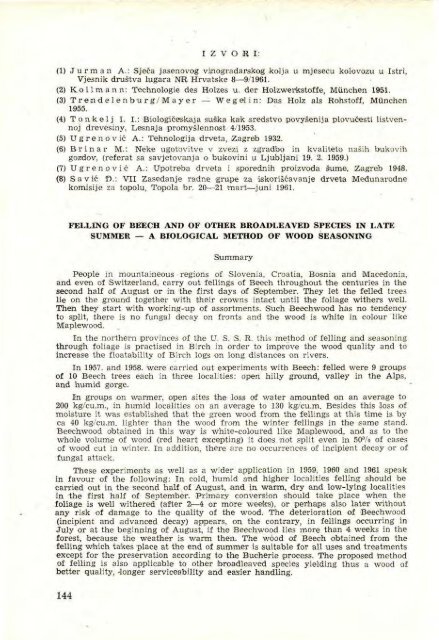You also want an ePaper? Increase the reach of your titles
YUMPU automatically turns print PDFs into web optimized ePapers that Google loves.
IZVORI:<br />
(1) Jurman A.: Sječa jasenovog vinogradarskog kolja u mjesecu kolovozu u Istri,<br />
Vjesnik društva lugara NR Hrvatske 8—9/1961.<br />
(2) Kollmann: Technologie des Holzes u. der Holzwerkstoffe, München 1951.<br />
(3) Trendelenburg/Mayer — Wegelin: Das Holz als Rohstoff, München<br />
1955.<br />
(4) Tomkelj I. I.: Biologičeskaja šuška kak sredstvo povysenija plovučesti listvennoj<br />
drevesiny, Lesnaja promyslennost 4/1953.<br />
(5) Ugrenović A.: Tehnologija drveta, Zagreb 1932.<br />
(6) B r i n a r M.: Neke ugotovitve v zvezi z zgrađbo in kvaliteto naših bukovih<br />
gozdov, (referat sa savjetovanja o bukovini u Ljubljani 19. 2. 1959.)<br />
(7) Ugrenović A.: upotreba drveta i sporednih proizvoda šume, Zagreb 1948.<br />
(8) Savić Đ.: VII Zasedanje radne grupe za iskorišćavanje drveta Međunarodne<br />
komisije za topolu, Topola tor. 20'—21 mart—juni 1961.<br />
FELLING OF BEECH AND OF OTHER BROADLEAVED SPECIES IN LATE<br />
SUMMER — A BIOLOGICAL METHOD OF WOOD SEASONING<br />
Summary<br />
People in mountaineous regions of Slovenia, Croatia, Bosnia and Macedonia,<br />
and even of Switzerland, carry out fellings of Beech throughout the centuries in the<br />
second half of August or in the first days of September. They let the felled trees<br />
lie on the ground together with their crowns intact until the foliage withers well.<br />
Then they start with working-up of assortments. Such Beechwood has no tendency<br />
to split, there is no fungal decay on fronts and the wood is white in colour like<br />
Maplewood.<br />
In the northern provinces of the U. S. S. R. this method of felling and seasoning<br />
through foliage is practised in Birch in order to improve the wood quality and to<br />
increase the floatability of Birch logs on long distances on rivers.<br />
In 1957. and 1958. were carried out experiments with Beech: felled were 9 groups<br />
of 10 Beech trees each in three localities: open hilly ground, valley in the Alps,<br />
and humid gorge.<br />
In groups on warmer, open sites the loss of water amounted on an average to<br />
200 kg/cu.m., in humid localities on an average to 130 kg/cu.m. Besides this loss of<br />
moisture it was established that the green wood from the fellings at this time is by<br />
ca 40 kg/cu.m. lighter than the wood from the winter fellings in the same stand.<br />
Beechwood obtained in this way is white-coloured like Maplewood, and as to the<br />
whole volume of wood (red heart excepting) it does not split even in 50°/o of cases<br />
of wood cut in winter. In addition, there are no occurrences of incipient decay or of<br />
fungal attack.<br />
These experiments as well as a wider application in 1959, 1960 and 1961 speak<br />
in favour of the following: In cold, humid and higher localities felling should be<br />
carried out in the second half of August, and in warm, dry and low-lying localities<br />
in the first half of September. Primary conversion should take place when the<br />
foliage is well withered (after 2—4 or more weeks), or perhaps also later without<br />
any risk of damage to the quality of the wood. The deterioration of Beechwood<br />
(incipient and advanced decay) appears, on the contrary, in fellings occurring in<br />
July or at the beginning of August, if the Beechwood lies more than 4 weeks in the<br />
forest, because the weather is warm then. The wood of Beech obtained from the<br />
felling which takes place at the end of summer is suitable for all uses and treatments<br />
except for the preservation according to the Bucherie process. The proposed (method<br />
of felling is also applicable to other broadleaved species yielding thus a wood of<br />
better quality, -longer serviceability and easier handling.<br />
144

















